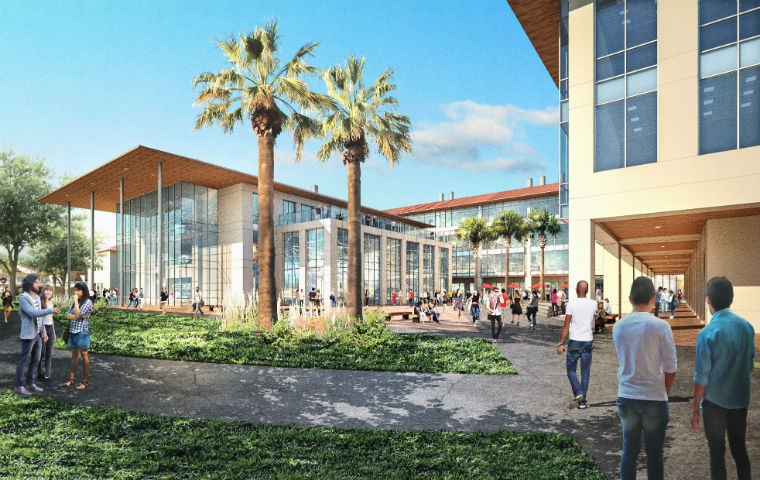
Gift from Sobratos for New STEM Facility
Lisa Krieger
The following story first appeared in the San Jose Mercury News.
Santa Clara University plans to build an ambitious new science, technology, engineering and math hub, backed by a record $100 million gift from Susan and John A. Sobrato, an SCU alumnus and founder of one of Silicon Valley’s largest commercial development firms.
The elegant new building, outfitted with state-of-the-art laboratories and equipment, could be a game-changer for the private, 165-year-old Jesuit university whose reputation was built on the liberal arts, creating a rare opportunity to link fast-moving technical fields with the school’s long-standing commitment to ethics.
The gift from the Sobratos, announced Saturday night, is the largest ever for the university, which was established in 1851 and is the oldest operating institution of higher learning in California. Construction of the new building is scheduled to start in the fall of 2018, with completion in 2020.
“We are building an environment which supports convergence … to solve problems and make an impact on the world,” said Dennis Jacobs, SCU’s provost. “This will connect science students with real-world problems, helping motivate those who want to make a difference, who want to do good.”
The 300,000-square-foot building will serve only undergraduate students, unlike similar facilities at Stanford University and UC Berkeley that are dedicated primarily to graduate-level research work.
Santa Clara University was built around Mission Santa Clara, which was founded in 1777. The school has a strong tradition of educating future clergy, lawyers, ethicists and philosophers. Its motto is Ad Majorem Dei Gloriam, or “For the Greater Glory of God.”
But over time, as the bucolic campus became surrounded by a restless and relentlessly tech-focused Silicon Valley, its science and engineering buildings grew aged and isolated.
“The valley has changed,” said Sobrato, 77, a graduate of SCU’s class of 1960. “It is all software and biosciences. The labs and teaching facilities on campus were not designed for today’s needs.”
The new building will change that. While its aesthetics will echo the school’s Mission Revival architectural style, its three-wing design is contemporary. In the core of the building will be places for students to collaborate. Centrally located on campus, it will replace the existing engineering building and law school, which is also getting a new building.
“The valley has changed,” said Sobrato, 77, a graduate of SCU’s class of 1960. “It is all software and biosciences. The labs and teaching facilities on campus were not designed for today’s needs.”
The new building will change that. While its aesthetics will echo the school’s Mission Revival architectural style, its three-wing design is contemporary. In the core of the building will be places for students to collaborate. Centrally located on campus, it will replace the existing engineering building and law school, which is also getting a new building.
The Sobratos’ donation is the lead gift in a $275 million fundraising goal, part of a broad initiative at Santa Clara University over the past several years to bring together the subjects of science, technology, engineering and mathematics — known as the STEM fields — in new and innovative ways, said Sobrato and provost Jacobs.
Currently, the disciplines are “in silos — you don’t see how they connect,” said Michelle Marvier, an assistant professor of biology at Santa Clara University. As a biology major at the university in the 1980s, she recalled, “I never once walked into an engineer classroom or research center at all.”
Added Marvier: “This mode of a single researcher in a single isolated space is a thing of the past. The facility will break down barriers and bring people together. When you look around Silicon Valley, that is how real breakthroughs are made.”
Ethics are an integral part of many of the world’s challenges, such as climate change, robotics and genetic engineering, Jacobs said. “The distinction of a Jesuit philosophy is not just about good-paying jobs, which are important, but also a more intrinsic sense that we think about those in the community with the greatest needs,” he said.
The gift offers a sweet taste of irony for Sobrato, who once dreamed of becoming an engineer — following in the footsteps of a godfather, a successful bridge-builder — but faltered.
“I did terribly,” he laughed. “I was put on probation.”
Then he switched to business and excelled. He arranged his class schedule so he could start selling Eichler houses in Palo Alto three days a week after getting his real estate license at 19, according to SCU. Three years later, he founded Midtown Realty and was the youngest member of the Million Dollar Club of the Palo Alto Real Estate Board. In 1972, he sold Midtown Realty to focus exclusively on high-tech commercial properties. He went on to found The Sobrato Organization.
Sobrato’s sons, daughter and grandchildren also graduated from the university, and he currently serves on the school’s board of trustees.
Donations are the lifeblood of universities, which cannot afford new construction solely on tuition revenue. The Sobratos are long-standing benefactors, donating $20 million to build SCU’s Joanne E. Harrington Learning Commons, Sobrato Family Technology Center and the Orradre Library.
Gifts from the Sobrato family have also supported other major capital projects on campus, including the John A. and Susan Sobrato Residential Learning Complex and Abby Sobrato Mall, named after John’s late daughter-in-law.
“We think it important,” John Sobrato said, “to give back to an institution that helped frame our lives and taught us good Jesuit values.”